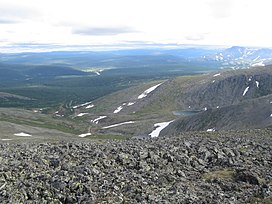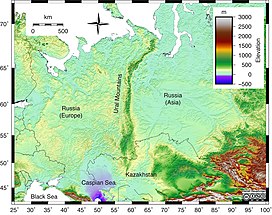| Ural Mountains | |
|---|---|
 Landscape in the northern part of the Ural Mountains (Khanty-Mansi Autonomous Okrug) | |
| Highest point | |
| Peak | Mount Narodnaya |
| Elevation | 1,895 m (6,217 ft) |
| Dimensions | |
| Length | 2,500 km (1,600 mi) |
| Width | 150 km (93 mi) |
| Geography | |
| Countries | Russia and Kazakhstan |
| Range coordinates | 60°N 59°ECoordinates: 60°N 59°E |
| Geology | |
| Orogeny | Uralian orogeny |
| Age of rock | Carboniferous |
| Type of rock | Metamorphic, igneous, sedimentary |
The Ural Mountains (/ˈjʊərəl/ YOOR-əl; Russian: Ура́льские го́ры, tr. Uralskiye gory, IPA: [ʊˈralʲskʲɪjə ˈɡorɨ]; Bashkir: Урал тауҙары) or simply the Urals, is a mountain range in Asia that runs north-south mostly through Russia, from the coast of the Arctic Ocean to the river Ural and northwestern Kazakhstan.[1] The mountain range forms part of the conventional boundary between the regions of Europe and Asia. Vaygach Island and the islands of Novaya Zemlya form a further continuation of the chain to the north into the Arctic Ocean. The average altitudes of the Urals are around 1,000–1,300 metres (3,300–4,300 ft), the highest point being Mount Narodnaya, which reaches a height of 1,894 metres (6,214 ft).[2]
The mountains lie within the Ural geographical region and significantly overlap with the Ural Federal District and the Ural economic region. Their resources include metal ores, coal, and precious and semi-precious stones. Since the 18th century the mountains have contributed significantly to the mineral sector of the Russian economy. The region is one of the largest centres of metallurgy and heavy industry production in Russia.[3]
https://en.wikipedia.org/wiki/Ural_Mountains


No comments:
Post a Comment